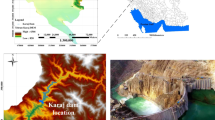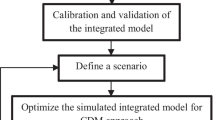Abstract
The conjunctive use of surface and groundwater resources is one alternative for optimal use of available water resources in arid and semiarid regions. The optimization models proposed for conjunctive water allocation are often complicated, nonlinear, and computationally intensive, especially when different stakeholders are involved that have conflicting interests. In this article, a new conflict-resolution methodology developed for the conjunctive use of surface and groundwater resources using Nondominated Sorting Genetic Algorithm II (NSGA-II) and Young Conflict-Resolution Theory (YCRT) is presented. The proposed model is applied to the Tehran aquifer in the Tehran metropolitan area of Iran. Stakeholders in the study area have conflicting interests related to water supply with acceptable quality, pumping costs, groundwater quality, and groundwater table fluctuations. In the proposed methodology, MODFLOW and MT3D groundwater quantity and quality simulation models are linked with the NSGA-II optimization model to develop Pareto fronts among the objectives. The best solutions on the Pareto fronts are then selected using YCRT. The results of the proposed model show the significance of applying an integrated conflict-resolution approach to conjunctive use of surface and groundwater resources in the study area.













Similar content being viewed by others
References
Brown LD (1995) Managing conflict among groups. In: Kolb DA, Osland JS, Rubin IM (eds) The organizational behaviour reader, 6th edn. Prentice-Hall, Englewood Cliffs, NJ, pp 317–328
Carraro C, Marchiori C, Sgobbi A (2005) Applications of negotiation theory to water issues. University Ca' Foscari of Venice, Department of Economics Research Paper Series No. 09/06, FEEM Working Paper No. 65.05, World Bank Policy Research Working Paper No. 3641
Coppola E Jr, Szidarovszky F (2004) Conflict between water supply and environmental health risk: a computational neural network approach. International Game Theory Review 6:475–492
Das A, Datta B (2001) Application of optimization in groundwater quantity and quality management. Sadhana 26:293–316
Deb K (2001) Multi-objective optimization using evolutionary algorithms. Wiley, New York
Deb K, Agrawal S, Pratap A, Meyarivan T (2000) A fast elitist non-dominated sorting genetic algorithm for multi-objective optimization: NSGA-II., KANGAL Rep. No. 200001. Indian Institute of Technology, Kanpur, India
Deb K, Pratap A, Agarwal S, Meyarivan T (2002) A fast and elitist multiobjective genetic algorithm: NSGA-II. IEEE Transactions on Evolutionary Computation 6:182–197
Dorn JL, Ranjithan S (2003) Evolutionary multiobjective optimization in watershed water quality management. In: Fonseca et al (eds) Evolutionary multi-criteria optimization. Lecture notes in computer science, vol 2632. Springer-Verlag, Berlin, pp 692–706
Gopalakrishnan C, Levy J, Li KW, Hipel KW (2005) Water allocation among multiple stakeholders: conflict analysis of the Waiahole water project. Hawaii Water Resources Development 21:283–295
Hammer MJ, Hammer MJ Jr (1996) Water and wastewater technology. Prentice Hall, New Jersey
Harbaugh AW, McDonald MG (1996) User’s documentation for MODFLOW-96, an update to the U.S. Geological Survey modular finite-difference groundwater flow model. Open file report 96-485. United States Geological Survey
Karamouz M, Kerachian R, Zahraie B (2004) Monthly water resources and irrigation planning: case study of conjunctive use of surface and groundwater resources. Journal of Irrigation and Drainage Engineering 130:93–98
Karamouz M, Rezapour Tabari MM, Kerachian R (2007) Application of genetic algorithm and artificial neural networks in conjunctive use of surface and groundwater resources. Water International 32:163–176
Kerachian R, Karamouz M (2006) Optimal reservoir operation considering the water quality issues: a deterministic and stochastic conflict resolution approach. Water Resources Research 42:1–17
Kerachian R, Karamouz M (2007) A stochastic conflict resolution model for water quality management in reservoir-river systems. Advances in Water Resources 30:866–882
Lejano RP, Davos CA (1995) Cost allocation of multiagency water resource projects: game theoretic approaches and case study. Water Resources Research 31:1387–1393
Loaiciga HA (2004) Analytic game-theoretic approach to groundwater extraction. Journal of Hydrology 297:22–33
Napel S (2002) Bilateral bargaining: theory and applications. Springer-Verlag, Berlin
Reed MR, Minsker BS (2004) Striking the balance: long-term groundwater monitoring design for conflicting objectives. Journal of Water Resource Planning and Management 130:140–149
Richards A, Singh N (1996) Two level negotiations in bargaining over water. Working paper, Department of Economics, University of California, Santa Cruz, CA 95064, pp 1–23
Salazar R, Szidarovszky F, Coppola E Jr, Rojana A (2007) Application of game theory for a groundwater conflict in Mexico. Journal of Environmental Management, 84(4):560–571
Shirangi E, Kerachian R, Bajestan SM (2008) A simplified model for reservoir operation considering the water quantity issues: Application of the Young Conflict Resolution Theory. Environmental Monitoring and Assessment. Springer. doi:10.1007/s10661-007-0061-0
Supalla R, Klaus B, Yeboah O, Bruins R (2002) A game theory approach to deciding who will supply instream flow water. Journal of the American Water Resources Association 38:959–966
Yandamuri SRM, Srinivasan K, Bhallamudi SM (2006) Multiobjective optimal waste load allocation models for rivers using non-dominated sorting genetic algorithm-II. Journal of Water Resource Planning and Management 132:133–143
Yeh WW-G (1992) Systems analysis in ground-water planning and management. Journal of Water Resource Planning and Management 118:224–237
Young HP (1993) An evolutionary model of bargaining. Journal of Economic Theory 59:145–168
Zheng C, Wang PP (1999) A modular three-dimensional multispecies transport model for simulation of advection, dispersion and chemical reactions of contaminants in groundwater systems, documentation and user’s guide, United States Army Corp of Engineers, Washington, DC, 220 pp
Acknowledgements
The technical contributions of Barbara S. Minsker (School of Civil and Environmental Engineering, University of Illinois at Urbana–Champaign, IL) and Hossein Sedghi, (Department of Hydraulic Structures, Islamic Azad Univesity—Tehran Science and Research Branch, Tehran, Iran) are acknowledged. The authors also thank anonymous reviewers for insightful comments that improved the quality of this article.
Author information
Authors and Affiliations
Corresponding author
Rights and permissions
About this article
Cite this article
Bazargan-Lari, M.R., Kerachian, R. & Mansoori, A. A Conflict-Resolution Model for the Conjunctive Use of Surface and Groundwater Resources that Considers Water-Quality Issues: A Case Study . Environmental Management 43, 470–482 (2009). https://doi.org/10.1007/s00267-008-9191-6
Received:
Revised:
Accepted:
Published:
Issue Date:
DOI: https://doi.org/10.1007/s00267-008-9191-6




